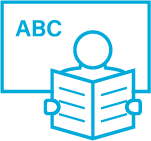Letter Knowledge Predicts Grade 4 Reading Fluency and Reading Comprehension
The present study examined the predictors of fourth-grade learners’ reading skills (reading comprehension, text reading and word chain reading). The results showed that children’s letter knowledge at the beginning of kindergarten was the most powerful predictor of their reading skills at the end of Grade 4. Other predictors were metacognitive awareness, gender, mother’s level of education, and visual attention.
Authors: Ulla Leppänen, Kaisa Aunola, Pekka Niemi & Jari-Erik Nurmi
Source: Leppänen, U., Aunola, K., Niemi, P., & Nurmi, J.-E. (2008). Letter knowledge predicts Grade 4 reading fluency and reading comprehension. Learning and Instruction, 18, 548-564. DOI: 10.1016/j.learninstruc.2007.11.004
The present study examined the predictors of fourth-grade learners’ reading skills (reading comprehension, text reading and word chain reading). The reading skill antecedents of 158 children aged 5–6 years were measured at the beginning of kindergarten. Students’ reading skills were measured in kindergarten and again in Grades 1 and 4. The results showed that children’s letter knowledge at the beginning of kindergarten was the most powerful predictor of their reading skills at the end of Grade 4. Other predictors were metacognitive awareness, gender, mother’s level of education, and visual attention.
- Decoding skills are of great importance in the early stage of the reading career, because they provide a basis for automaticity in word recognition.
- Skilled reading is a combination of accurate and automatic decoding that frees resources so that the meaning of what is being read can be understood.
Reading accuracy
- To develop adequate decoding and word recognition skills, children must progress through different stages.
- In Frith’s (1985) model, word recognition begins to develop along with the visual processing of printed words, progressing to a phase in which children use letter-sound correspondences for decoding.
- The process ends in the orthographic stage, in which children apply adaptive and flexible strategies to decide the most efficient way to decode the written text.
- Phonological awareness has been found to be associated with early word-reading skills.
- Letter knowledge provides a basis for understanding the alphabetic principle.
- Visual skills (such as automatic orientation of attention) provide a basis for subsequent decoding.
Fluent reading and reading comprehension
- Reading fluency has been suggested to be the product of the development of two components: accuracy and automaticity.
- Once decoding is accurate and automatic, more of the readers’ resources can be invested in comprehension.
- Reading comprehension requires the meaning of particular sentences to be derived together with text-modelling processes that are based on general knowledge and inference-drawing ability.
- Listening comprehension skills are suggested to be an important antecedent of reading comprehension.
- Metacognitive skills, such as the ability to monitor and evaluate one’s own progress in a particular task, are associated with reading comprehension skills.
- Naming speed has been suggested to play a role in both reading comprehension and reading fluency.
Social background factors
- Several family-related factors (such as parents’ education and socioeconomic status) may contribute to children’s reading development.
- Gender differences in reading performance have also been reported; girls outperform boys in reading measured between the ages of 9 and 14 years.
Orthographic nature of Finnish
- The highly regular correspondence between letters and sounds in Finnish makes it one of the most orthographically-shallow languages.
- In Finland, primary school begins when children are 7 years old.
- Reading is taught through phonics, for which the learning of sound-letter correspondence is important.
- Reading instruction includes letter recognition, listening, segmenting, and blending phonemes and syllables.
Present study
The present study examined the following research questions:
- To what extend do letter knowledge, phonological awareness, and listening comprehension (measured at the beginning of kindergarten) predict children’s text and word chain reading and reading comprehension at the end of Grade 4?
- To what extent do other cognitive abilities (such as metacognitive awareness and visual attention) predict text and word chain reading and reading comprehension at the end of Grade 4?
- To what extent does mother’s educational level predict children’s text and word chain reading and reading comprehension at the end of Grade 4?
- To what extent is gender associated with text and word chain reading and reading comprehension at the end of Grade 4?
- At what stage of the reading career do the different antecedents begin to operate?
- Would controlling for rapid serial naming and general cognitive ability change the results?
Method
This study is part of the Jyväskylä Entrance into Primary School (JEPS) Study conducted by Nurmi and Aunola from 1999 to 2004. The aim of the study was to investigate the development of a broad range of cognitive, social, and motivational factors among children moving from kindergarten to primary school. The sample of the present study consisted of 196 children (92 girls, 104 boys) who participated during autumn term (Time 1) and spring term (Time 2) of kindergarten, and spring term of in Grade 1 (Time 3). At the fourth measurement point of the study (at the end of Grade 4), 158 children (75 girls, 83 boys) were assessed.
Findings
- In the first path model, reading comprehension and text and word chain reading at the end of Grade 4 were predicted by letter knowledge, phonological awareness, and listening comprehension at the beginning of kindergarten.
- The higher the level of letter knowledge at the beginning of kindergarten year, the higher the level of reading comprehension and text and word chain reading at the end of Grade 4.
- The higher the level of phonological awareness, the higher the level of word chain reading later.
- The higher the level of listening comprehension at the beginning of the kindergarten year, the higher the level of reading comprehension at the end of Grade 4.
- When metacognitive awareness and visual attention at the beginning of kindergarten were added to the model, the results for letter knowledge, phonological awareness, and listening comprehension remained the same.
- Visual attention at the beginning of kindergarten predicted both reading comprehension and word chain reading.
- Reading comprehension was predicted by metacognitive awareness.
- At the third step, mother’s educational level was added to the model. The paths from step 2 remained the same, except the association from visual attention to reading comprehension decreased to a statistically nonsignificant level.
- Mother’s educational level added to the prediction of reading comprehension skills.
- Child’s gender was added to the previous model at a fourth step. The paths of the previous step remained the same.
- The results showed that children’s gender predicted their reading comprehension: girls showed a higher level of reading comprehension skills in Grade 4 than boys.
- At the fifth step, earlier levels of reading performance at the end of kindergarten and at the end of Grade 1 were added as predictors for reading variables at the end of Grade 4.
- The results for visual attention, mother’s education, and gender remained the same compared to the model of step 4.
- Besides having a direct effect on reading comprehension and text reading, letter knowledge had an indirect effect on reading comprehension and text reading via reading skills at the end of Grade 1.
- After taking into account kindergarten and Grade 1 reading skills, letter knowledge had only an indirect effect on word chain reading.
- The impact of phonological awareness on reading comprehension, text reading, and word chain reading was mediated by the reading skills measured at the end of the kindergarten year and at the end of Grade 1.
- Besides having direct effect on reading comprehension, metacognitive awareness had an additional indirect effect on reading comprehension, text reading, and word chain reading via reading skills at the end of Grade 1.
- After controlling for the earlier levels of reading skills, the path from listening comprehension to reading comprehension disappeared.
- The results demonstrated that the level of reading skills at the end of Grade 1 predicted all the outcome measures.
- At the sixth step, rapid serial naming (measured in Grade 4) was added as a predictor in the previous model; however, performance on the rapid serial naming task did not add to the prediction of measures of reading skill at the end of Grade 4.
- At the final step, the impact of general cognitive ability was also tested, but this did not change any of the previous results.
Conclusions
- The results showed that although phonological awareness at the beginning of kindergarten predicted reading fluency and reading comprehension at the end of Grade 4, these effects were mediated by reading skills at the end of kindergarten and Grade 1 (in other words, phonological awareness contributed to reading performance at kindergarten and Grade 1, which then predicted reading performance at Grade 4).
- The best predictor of reading comprehension and reading fluency at the end of Grade 4 was letter knowledge at the beginning of the kindergarten year.
- The findings suggest that besides being a powerful predictor of beginning reading ability, early letter knowledge is also predictive of later development of fluent reading.
- Mothers’ educational level predicted their children’s performance in reading comprehension tasks at the end of Grade 4, even after controlling for children’s reading skills in Grade 1.
- The results confirmed that girls performed better than boys in reading comprehensions tests.



